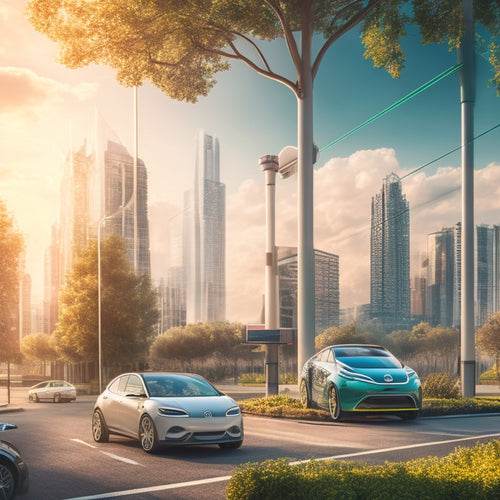
Smart City Essentials for EV-Friendly Infrastructure
Share
As you plan and design EV-friendly infrastructure, incorporating a dense network of charging stations, smart traffic management systems, and sustainable energy grid integration is vital to support the widespread adoption of electric vehicles and alleviate range anxiety. You'll need to take into account a minimum ratio of public charging points to EVs of 1:10, strategically placing them in high-demand locations like shopping centers and office buildings. Your city's unique needs will also necessitate smart traffic management systems, leveraging real-time data analytics and IoT sensors to optimize traffic flow and reduce congestion. By exploring these essentials, you'll uncover more ways to create a seamless EV-friendly experience.
Key Takeaways
• A dense network of EV charging stations, with a minimum ratio of 1:10 public charging points to EVs, is crucial for widespread adoption.
• Strategically placed charging stations in urban areas, such as shopping centers and office buildings, alleviate range anxiety.
• Incorporating EV charging infrastructure into green spaces, like parklets, promotes sustainable urban planning and mitigates the urban heat island effect.
• Smart traffic management systems, utilizing real-time data analytics and IoT sensors, optimize traffic flow and reduce congestion in EV-friendly cities.
• Sustainable energy grid integration, prioritizing renewable energy sources and energy storage solutions, supports the increased power demand from EVs.
EV Charging Station Infrastructure
You'll need a dense network of EV charging stations, with a minimum of 1:10 ratio of public charging points to EVs, to support widespread adoption and alleviate range anxiety. This means strategically placing charging stations in urban areas, prioritizing high-demand locations like shopping centers, office buildings, and public parking lots.
A well-designed charging station should have multiple charging points, high-power charging capabilities, and convenient payment systems. Urban planning strategies play an important role in determining the best location and layout of these stations. Effective Charging Station Design involves considering factors like accessibility, visibility, and safety.
For instance, stations should be situated near pedestrian walkways, have clear signage, and be well-lit to ensure user comfort. By integrating EV charging infrastructure into urban planning, cities can create an EV-friendly environment that encourages adoption and supports sustainable transportation.
Smart Traffic Management Systems
Optimizing traffic flow and reducing congestion are critical goals of smart traffic management systems, which leverage real-time data analytics, IoT sensors, and advanced algorithms to dynamically adjust traffic signal timings and traffic routing. As you navigate through the city, you'll benefit from the seamless integration of these technologies.
Here's a breakdown of the key components involved:
| Technology | Function | Benefits |
|---|---|---|
| Real-time Data Analytics | Provides insights on traffic patterns and volumes | Enables data-driven decision-making |
| IoT Sensors | Monitors traffic conditions in real-time | Accurate and timely data collection |
| Advanced Algorithms | Optimizes traffic signal timings and routing | Reduces congestion and travel times |
Sustainable Energy Grid Integration
As you electrify your transportation network, ensuring a sustainable energy grid integration becomes essential to support the increased power demand from EVs, while minimizing strain on the grid and mitigating potential blackouts.
You'll need to prioritize renewable sourcing to offset the additional energy requirements. This can be achieved through investments in solar, wind, or hydroelectric power. By incorporating these clean energy sources, you'll reduce your reliance on fossil fuels and decrease greenhouse gas emissions.
To further optimize your energy grid, consider implementing energy storage solutions like batteries or other innovative technologies. These systems can absorb excess energy generated during off-peak hours and release it when demand peaks, reducing strain on the grid.
By integrating energy storage, you'll improve the overall efficiency and resilience of your energy infrastructure. Additionally, this approach will enable you to better manage energy distribution, ensuring a reliable and sustainable supply to support the growing number of EVs on your roads.
Electric Vehicle Data Analytics
As you design EV-friendly infrastructure, you need to make data-driven decisions, and that's where electric vehicle data analytics comes in.
You'll want to analyze vehicle charging patterns to identify trends and optimize charging times, while also gaining insights into energy consumption to minimize strain on the grid.
Vehicle Charging Patterns
By analyzing electric vehicle (EV) charging patterns, you can uncover valuable insights into driver behavior, energy consumption, and infrastructure utilization, providing a data-driven foundation for EV-friendly infrastructure development. This analysis is essential in understanding how EV owners interact with charging stations, identifying areas of improvement, and optimizing infrastructure to meet growing demand.
To better understand charging patterns, consider the following key aspects:
-
Charging Habits: Identifying frequent charging locations, such as home, work, or public stations, helps you understand driver behavior and optimize infrastructure placement.
-
Peak Hours: Analyzing peak charging hours, typically during evening commute times, enables you to plan for increased energy demand and prevent grid overload.
-
Duration and Frequency: Understanding how long and how often EV owners charge their vehicles helps you optimize charging station capacity and reduce congestion.
- Charging Speed: Knowing the preferred charging speed, such as Level 2 or DC Fast Charging, informs infrastructure development to meet driver needs.
Energy Consumption Insights
Your electric vehicle data analytics can uncover hidden patterns in energy consumption, revealing when and how drivers use their vehicles, how much energy they consume, and what factors influence their behavior. By analyzing your data, you can identify opportunities to optimize energy efficiency and reduce peak demand.
For instance, you might discover that most drivers charge their vehicles during off-peak hours, reducing strain on the grid. You might also find that certain demographics, such as younger drivers, consume more energy than others. These insights can inform targeted campaigns to promote energy-efficient driving habits and optimize charging schedules.
With granular data on energy consumption, you can pinpoint areas for improvement in your EV infrastructure. You might identify charging stations that are underutilized or those that experience high demand during peak hours. By leveraging these insights, you can optimize your infrastructure to meet the unique needs of your drivers, reducing congestion and strain on the grid.
Grid Impact Analysis
With electric vehicle data analytics, you can quantify the grid impact of EV adoption, measuring the strain on the electrical distribution system and identifying potential bottlenecks in the infrastructure. This analysis is essential to verify that your city's electrical grid can support the increased demand from EV charging.
By leveraging advanced data analytics, you can:
-
Optimize load forecasting: Accurately predict energy demand and adjust your grid management strategy accordingly.
-
Implement peak shaving: Reduce peak energy consumption during periods of high demand, alleviating strain on the grid.
-
Identify areas for infrastructure upgrades: Pinpoint specific locations where grid reinforcement is necessary to support EV adoption.
- Develop targeted demand response programs: Create programs that incentivize EV owners to charge their vehicles during off-peak hours, reducing strain on the grid.
Green Spaces for EV Parking
In addition to designing your city's EV-friendly infrastructure, don't overlook the importance of green spaces for EV parking. Nearly 80% of electric vehicle (EV) owners prefer to charge their vehicles at home, leaving a significant demand for EV-friendly parking infrastructure in public green spaces.
When it comes to urban forestry, incorporating EV charging stations into parklet designs can be a game-changer. By integrating charging infrastructure into green spaces, you can create a seamless charging experience for EV owners while also promoting sustainable urban planning.
Parklet design can be optimized to accommodate EV charging stations, providing a convenient and eco-friendly solution for drivers. Additionally, incorporating urban forestry principles can help mitigate the urban heat island effect, reduce air pollution, and enhance biodiversity.
Incentivizing EV Adoption Policies
As you develop your city's EV-friendly infrastructure, you'll want to implement policies that incentivize citizens to adopt electric vehicles.
Two key strategies worth exploring are offering tax credits and rebates to offset the higher upfront costs of EVs, and designating low-emission zones to restrict access to polluting vehicles.
Tax Credits and Rebates
You can accelerate EV adoption by leveraging tax credits and rebates, which offer a tangible incentive for individuals and businesses to invest in electric vehicles. These financial incentives can greatly reduce the upfront cost of purchasing an EV, making them more appealing to a wider audience.
To maximize the impact of your EV-friendly infrastructure, understanding the various tax credits and rebates available is crucial.
Here are some key incentives to explore:
-
Federal Incentives: The federal government offers a tax credit of up to $7,500 for the purchase of a qualifying EV.
-
State Rebates: Many states offer additional rebates, such as California's Clean Vehicle Rebate Project, which provides up to $5,000 for the purchase of an EV.
-
Utility Company Incentives: Some utility companies offer special EV rates, discounts, or rebates for EV owners.
- Local Government Incentives: Municipalities may offer additional incentives, such as free parking or toll passes, for EV owners.
Low-Emission Zones
By establishing low-emission zones, cities can implement policies that actively incentivize EV adoption, such as restricting access to certain areas for non-EV vehicles or offering preferential parking and toll rates for EV owners. This approach not only improves air quality but also encourages a shift towards sustainable transportation.
| Zone Type | Restrictions | Benefits |
|---|---|---|
| Low-Emission Zone | Restrict non-EV access | Improved air quality, reduced congestion |
| Priority Parking Zone | Reserve spots for EVs | Increased EV adoption, reduced parking time |
| Toll-Free Zone | Waive tolls for EVs | Encouraged EV use, reduced traffic |
As you expand low-emission zones, you can monitor air quality improvements and adjust policies accordingly. Zone expansion can be data-driven, targeting areas with high pollution levels or traffic congestion. By analyzing traffic patterns and air quality data, you can identify the best zone locations and boundaries. This data-driven approach ensures that your low-emission zones are effective in reducing emissions and promoting EV adoption.
Frequently Asked Questions
Can Existing Parking Garages Be Retrofitted for EV Charging Stations?
You'll face retrofitting challenges, but yes, you can convert existing parking garages for EV charging stations. Expect garage modifications, such as upgrading electrical infrastructure and installing charging stations, to guarantee a seamless shift.
How Do Smart Traffic Management Systems Prioritize EVS in Traffic Flow?
As you navigate the urban jungle, you'll find that smart traffic management systems use real-time data to analyze traffic patterns, designating priority lanes for EVs, ensuring a smooth ride and reducing congestion, making your commute a breeze.
Are There Incentives for Private Companies to Develop Ev-Friendly Infrastructure?
You'll find that private companies can tap into tax breaks and government grants, incentivizing them to develop EV-friendly infrastructure, as they can offset development costs and boost their bottom line.
Can EV Charging Stations Be Powered by On-Site Renewable Energy Sources?
You can power EV charging stations with on-site renewable energy sources, leveraging energy harvesting to reduce reliance on the grid. This setup enables a sustainable grid, minimizing carbon footprint and energy costs.
How Do Cities Ensure Public Access to EV Charging Infrastructure?
'You'll find that 80% of EV owners charge at home, but for the rest, cities guarantee public access to EV charging infrastructure through equitable distribution and strategic urban planning, prioritizing high-demand areas like shopping districts and transportation hubs.'
Related Posts
-

5 Best Practices for Long-Lasting Sustainable Batteries
To maximize the lifespan of your batteries, you should optimize charging cycles by maintaining a charge level between...
-

What Are the Best Eco-Friendly Rides for Campus?
As you navigate your college campus, you have a wide range of eco-friendly ride options to choose from, including bic...
-

Designing Efficient Vehicle Charging Infrastructure Systems
As you design efficient vehicle charging infrastructure systems, prioritize strategic planning and optimization to av...


